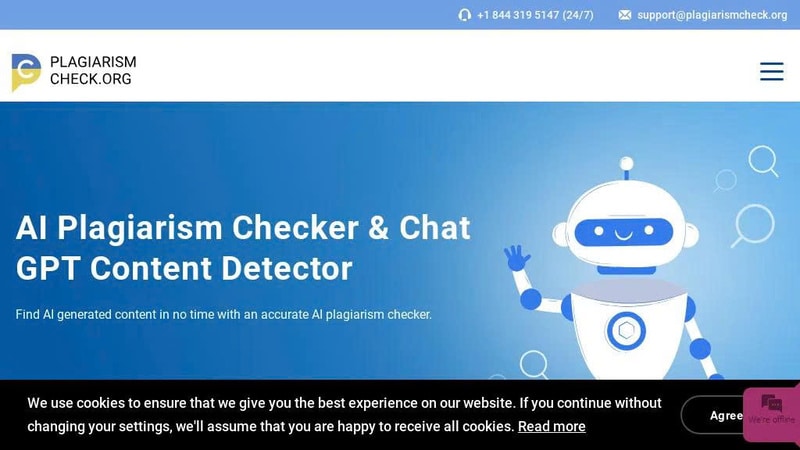Find out how an AI Code Detector can find source code plagiarism in schools and businesses. Find out how these tools function and why they are so important right now.
What AI Code Detectors Are and Why They Are Important
Software development and coding instruction have become more popular than ever in the digital transformation period. Code plagiarism has become much easier and more tempting since learning platforms, collaborative projects, and open-source repositories are easier to get to. Finding copied essays or articles is far easier than finding copied source code, though. This is where the AI Code Detector comes in.
AI-powered technologies are changing the way businesses, schools, and developers check for code originality. An AI Code Detector doesn’t only look for precise text matches like traditional plagiarism detection does. It also looks at logic, structure, and even how variables are named. It employs machine learning to find deeper patterns and meanings that could show that code has been copied, even if the original version has been hidden.

How Does an AI Code Detector Work?
Getting to Know the Main Idea Behind AI Code Detection
An AI Code Detector is a piece of software that uses artificial intelligence to find patterns and similarities in source code contributions. AI-based detectors look further than just basic comparison tools to look at:
- AST (Abstract Syntax Trees)
- What the code does and how it works
- How the code is set up and how it flows
- Similarity in semantics and logic
- Patterns for naming things and modular design
These capabilities help AI Code Detectors find situations where students or developers try to hide duplicated code by changing variable names, adding comments, or rearranging the order of functions.
How AI Code Detectors Work
AI Code Detectors usually use a combination of:
- Natural Language Processing (NLP): To read and understand comments or documentation published by people.
- Machine Learning Models: These are trained on huge sets of both clean and copied code.
- Graph Neural Networks: To help you figure out how code is structured and how it flows.
- Metrics of similarity, including the Levenshtein distance, the Jaccard similarity, or the cosine similarity in vector spaces.
Even when the code looks completely different to a human, the AI can find code that is comparable with a high degree of accuracy by using a combination of these methods.

Why the AI Code Detector is Important for Schools and Businesses
How to Stop Cheating in Programming Classes
As remote learning becomes more common, programming teachers have a lot of trouble making sure that students’ work is honest. Checking by hand takes a lot of time and is easy to miss things. An AI Code Detector lets teachers:
- Automatically examine a lot of submissions
- Find patterns of similarity that look suspect
- Point out possible instances of cheating or collaboration
- Give reports with proof for disciplinary measures
Also, these tools stop students from cheating by letting them know that their work is being closely watched.
Keeping software companies’ intellectual property safe
In the business sector, stealing code can cause problems with the law, hurt your reputation, and cost you money. Developers who employ proprietary code from one company in another or steal open-source code without giving credit are a threat. An AI Code Detector helps businesses:
- Check that employee code contributions are original
- Make sure they follow open-source licenses
- Keep their software repositories safe
- Find internal threats or corporate espionage
Best AI Code Detector Tools in 2025
- MOSS (Measure of Software Similarity)
MOSS is still frequently used in schools, even if it isn’t strictly AI-based. It focusses on structural similarities, and while it’s not as advanced as newer tools, it works quickly and well for simple comparisons.
- JPlag
JPlag works with more than one language and lets you see the differences. It’s great for schools, but it doesn’t have all the deep learning features it needs.
- Codequiry
Codequiry uses machine learning to find patterns in code that look suspicious. It finds attempts to disguise plagiarism and gives teachers a score for each contribution that shows how confident they are in it.
- Similarity of Turnitin Code (Beta)
Turnitin is known for checking academic writing, but it has added a new AI-powered module for checking code plagiarism. It works with a lot of LMS systems and can find when someone has copied the structure or logic of something else.
- Codio’s Code Playback and Similarity Check
Codio gives teachers tools to play back code and look for AI similarities. These tools assist teachers not just find plagiarism but also understand how their students code.

How to Add an AI Code Detector to Your Workflow for Teachers
- Connect the tool to your LMS, such as Moodle or Canvas.
- Set up automatic scans to run when code is submitted.
- Look over the similarity report made by the AI.
- If necessary, do manual reviews after that.
- Give comments or take academic action based on what you find.
For Managers and Developers
- Add code analysis to your CI/CD workflow.
- Use detectors to check code before you merge pull requests.
- Check the history of the repository from time to time.
- Keep an eye on work done by freelancers or outside providers.
- Keep a list of external libraries that are allowed.
Limitations and moral issues with AI code detectors
Context and false positives are important.
No tool for detection is flawless. An AI Code Detector might detect code that is identical because of:
- Common algorithm implementations (like bubble sort)
- Using well-known frameworks or libraries
- Template code given by the instructor
That’s why it’s still important for people to look over things to grasp them in context.
Data Ownership and Privacy
Students and developers should know that their code can be scanned. To utilise these technologies in an ethical way, you need to be open about where the data is held, if it’s shared with other people, and how long it stays in the detection system.
The best ways to avoid copying code
Tools are vital for finding things, but stopping them is just as critical. Encourage:
- Original project work gross with a personal touch
- Learning together but on your own
- Regular coding tests in class
- Keeping track of changes with code versioning
- Giving credit for reused code with comments
Is AI Code Detector better than a manual review?
There is a space for both. Manual review lets you make more nuanced decisions, while AI Code Detectors are fast and can handle a lot of data. A mix of approaches makes sure:
- AI does a quick first screening
- A human review looks at edge cases in more depth
- Grading and assessment are more accurate
The Future of AI Code Detectors in a World with GPT
It will be tougher to tell the difference between content produced by humans and content authored by AI as tools like ChatGPT get better at making code. New AI code detectors are getting better at:
- Finding AI-written code by looking for trends in how it was made
- Spotting style, logic, or structure problems
- Learning from big sets of AI-generated code to find more code faster
To stay ahead of the game, teachers and developers need to keep their detection tools up to date.
Why you need an AI Code Detector right now
Code plagiarism isn’t only a problem for students anymore; it’s a problem for teachers, developers, and corporations as well. We need to keep our defences up as AI gets better. The AI Code Detector isn’t simply useful now; it’s something you need for the future.
Integrating AI code detection into your workflow is not only a good idea, it’s also necessary if you want to protect academic integrity as a teacher or keep your proprietary code safe as a CTO.
To stay updated on the latest AI developments and tool reviews, follow us on our social media channels:
- YouTube: https://youtube.com/@AItoolsbiz
- Twitter: https://x.com/AItoolsbiz
- LinkedIn: https://www.linkedin.com/in/aitoolsbiz







